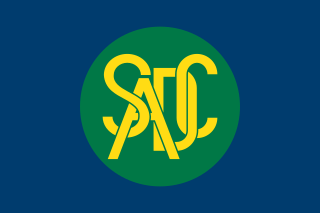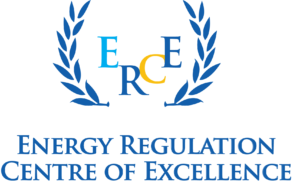
The Southern African Development Community (SADC) is an inter-governmental organization headquartered in Gaborone, Botswana.

The East African Community (EAC) is an intergovernmental organisation composed of eight countries in the great Lakes and horn of africa regions of Eastern Africa. The members are Democratic Republic of the Congo, the Federal Republic of Somalia, the republics of Burundi, Kenya, Rwanda, South Sudan, Uganda and the United Republic of Tanzania. Salva Kiir Mayardit, the president of South Sudan, is the current EAC chairman. The organisation was founded in 1967, collapsed in 1977, and was revived on 7 July 2000.

The Tanzania Electric Supply Company Limited (TANESCO) is a Tanzanian parastatal organisation established in 1964. It is wholly owned by the government of Tanzania. The Ministry of Energy and Minerals regulates the operations of TANESCO.
The Regional Economic Communities (RECs) in Africa group together individual countries in subregions for the purposes of achieving greater economic integration. They are described as the "building blocks" of the African Union and are also central to the strategy for implementing the New Partnership for Africa's Development (NEPAD).

The Electricity Regulatory Authority (ERA) is a government agency that regulates, licenses, and supervises the generation, transmission, distribution, sale, export, and importation of electrical energy in Uganda.

Water supply and sanitation in Tanzania is characterised by: decreasing access to at least basic water sources in the 2000s, steady access to some form of sanitation, intermittent water supply and generally low quality of service. Many utilities are barely able to cover their operation and maintenance costs through revenues due to low tariffs and poor efficiency. There are significant regional differences and the best performing utilities are Arusha and Tanga.
Central Electricity Regulatory Commission (CERC), a key regulator of power sector in India, is a statutory body functioning with quasi-judicial status under sec – 76 of the Electricity Act 2003. CERC was initially constituted on 24 July 1998 under the Ministry of Power's Electricity Regulatory Commissions Act, 1998 for rationalization of electricity tariffs, transparent policies regarding subsidies, promotion of efficient and environmentally benign policies, and for matters connected Electricity Tariff regulation. CERC was instituted primarily to regulate the tariff of Power Generating companies owned or controlled by the government of India, and any other generating company which has a composite scheme for power generation and interstate transmission of energy, including tariffs of generating companies.

The Energy Regulators Regional Association (ERRA) is a voluntary organization of independent energy regulatory bodies primarily from the Central European and Eurasian region, with Affiliates from Africa, Asia the Middle East and the USA.
Kikagati Hydroelectric Power Station, also referred to as Kikagati Power Station, is a 15.57 MW (20,880 hp) hydroelectric power station, in Uganda.

This article describes energy and electricity production, consumption, import and export in Kenya. Kenya's current effective installed electricity capacity is 2,651 megawatts (MW), with peak demand of 1,912 MW, as of November 2019. At that time, demand was rising at a calculated rate of 3.6 percent annually, given that peak demand was 1,770 MW, at the beginning of 2018. Electricity supply is mostly generated by renewable sources with the majority coming from geothermal power and hydroelectricity.

The East African Crude Oil Pipeline (EACOP), also known as the Uganda–Tanzania Crude Oil Pipeline (UTCOP), is a 1,443 km crude oil pipeline in planning since 2013, with a foundation stone nominally under construction since 2017 and intended to transport crude oil from Uganda's Tilenga and Kingfisher oil fields to the Port of Tanga, Tanzania on the Indian Ocean.
Benon Mugisha Mutambi is a Ugandan economist and civil servant, who has served as the permanent secretary in the Uganda Ministry of Internal Affairs, since December 2016. Prior to his appointment to the interior ministry, he served as the chief executive officer of Electricity Regulatory Authority (ERA), the government agency responsible for the regulation of electricity tariffs in Uganda.
Science and technology in Uganda examine government efforts to develop a national innovation system and the impact of these policies.
The Eastern Africa Power Pool (EAPP), is a collaborative effort by eleven countries in Eastern Africa to interconnect their electricity grids and take advantage of excess capacity within the network and facilitate trade of electric power between the members.

Geoffrey Aori Mabea is an energy economist and corporate executive and the current Executive Secretaryof the Energy Regulators Association of East Africa. He assumed office in 2020 as the first Executive Secretary of the regional Organisation with the mandate of spearheading establishment of the East African Community Energy Union. Prior to joining EREA, he was a researcher at the University of Dundee. He also served as a capital projects advisor with PwC.

The Zanzibar Utilities Regulatory Authority (ZURA) is a multisectoral government agency established under Act No. 7/2013 of the Laws of Zanzibar to provide technical and economic regulation in both electricity, petroleum and water sectors in Zanzibar, autonomous part of Zanzibar Archipelago, Tanzania, East Africa.

The Energy Regulation Centre of Excellence (ERCE) is a specialised Eastern African regional institution for Energy research and training in Energy regulation, Electricity market, Petroleum studies,Transmission network, Market clearing ,Energy law, Energy transition and Energy economics.

Rugigana Evariste is a Rwandan economist and politician.













